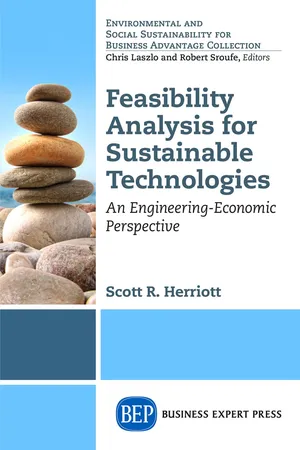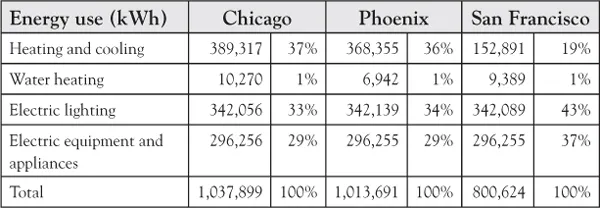![]()
CHAPTER 1
Sustainable Technologies
Overview
Feasibility analysis, as applied to the use of sustainable technology, is an interdisciplinary task. This book presents an engineering–economic perspective on technology that yields insights into the circumstances that make a technology economically viable. This chapter presents the main ideas of the book, giving the reader a taste of the engineering–economic perspective but without the depth that the later chapters provide. This chapter addresses the following questions:
• In the context of technology, what does sustainability mean?
• How do engineers use the concepts of input, process, and output to describe technologies?
• What concepts enable a technology analyst to describe devices of different sizes, and on what basis can technologies be compared with each other?
• How does an economist’s perspective on technology differ from that of an engineer?
• How does a financial analyst compare the costs of two devices that have different lifetimes and different costs to operate?
• How can one establish an objective value for a device, such as a solar panel or a wind turbine, as a point of reference in comparison with the price that a vendor is charging for it?
• What role does public policy have in promoting sustainable technologies, and how does government implement its policies?
What Makes a Technology Sustainable?
Table 1.1 presents a brief list of what people would generally consider to be sustainable or nonsustainable technologies across a variety of domains. Read through the list and see if you can identify the characteristics of a technology that distinguish it as sustainable.
Generalizing from this table, there seem to be three features that distinguish the sustainable from the nonsustainable technologies. One feature of energy technologies is renewability—energy from renewable sources such as the sun and wind is sustainable; energy from nonrenewable sources such as deposits of oil and natural gas is not sustainable. Another feature is efficiency and is seen most obviously in technologies that use energy. Our drive toward sustainability requires efficiency in the use of our limited resources. The third feature, which occurs in waste management, building technologies, and agriculture, is nontoxicity. Sustainable technologies do not create toxic effects for human life or the natural environment.
Table 1.1 Sustainable and nonsustainable technologies
| Category | Nonsustainable | Sustainable |
| Electric power generation | Coal-fired power plants
Oil and gas-fired power
Nuclear power (?) | Solar power
Wind power
Biogas power
Hydrogen fuel cell |
| Energy storage (including fuels) | Lead-acid batteries
Gasoline
Ethanol (?) | Pumped hydro (dams)
Biodiesel |
| Energy usage (lighting, heating/cooling, transportation) | Incandescent lights
Old home furnace
Gas-fired water heater
Internal combustion car | LED lights
Energy StarTM furnace
Solar water heater
Battery-electric vehicle |
| Waste management | Disposal in a landfill | Recycling
Biogas capture or digestion |
| Building technologies | Interior lighting
Gas furnace
High-VOC paints
Common thermostat | Day lighting
Geothermal heat pump
Non-VOC paints
Programmable thermostat |
| Agricultural technologies | Chemical-based agriculture | Organic agriculture |
The business press tends to equate sustainability with renewability, but efficiency is also very important to the future of human society. It is therefore not surprising that the U.S. Department of Energy established the Office of Energy Efficiency and Renewable Energy (EERE; www.eere.energy.gov) to promote each of these aspects of sustainability.
As a field of study, sustainable business goes beyond renewability, efficiency, and nontoxicity. It considers the social impacts of business, looking for ways to make businesses more resilient in the face of change and to help them nourish the lives of their stakeholders and flourish as organizations.1 Our study of sustainable technologies in this short book is developed around feasibility analysis, focusing on the attributes of technology seen through the eyes of the engineer and economist. The social impact of technology has its origin in how technology is used, not in the technology itself. The theme of sustainability raises important questions about appropriate technology—how the choice of technology depends on local knowledge and culture,2 but those are beyond the scope of this book.
What Is Technology?
Technology transforms one configuration of energy and matter into another configuration. For example, an automobile’s engine transforms the chemical energy in gasoline into the mechanical energy (motion) of the vehicle. Technology changes the state of matter–energy, so technology is best understood as a transformation process. From a scientific perspective, we may say that technology is the application of the laws of nature that govern the transformation process. From a business perspective, it is useful to think of technology as the intelligence by which one configuration of matter–energy becomes another. In that perspective, the progressive development of a technology is the refinement of the intelligence that is expressed in the transformation process.
Technology and Its Devices
When we define technology in this way, as a process, we focus our attention on the laws of nature by which the inputs become outputs. This perspective sees technology fundamentally as knowledge. So, what is a car or a computer? It is the device that embodies the knowledge. But even in such a context, the word technology can have different meaning at several levels of generality. The automotive engine can be called a technology. Within that class, a gasoline engine and a diesel engine might each be called a “technology.” Within the class of gasoline engines, the one that can also burn a fuel consisting 85 percent of ethanol (E85) might also be called a technology. Even more finely, we may still use the word technology to describe different sizes of E85-burning engine, such as 150 horsepower (HP), 250 HP, or 350 HP motors.
We may use any of the several words for these realizations of a technology. We might call a car or a computer a device, because it is a small and self-contained form of technology. We might call a solar photovoltaic (SPV) system an installation, because it is an assembly of components. We would call a large factory a plant, as in “electric power plant.”
In common parlance, people do not distinguish precisely between a technology and the devices, installations, or plants that realize the technology. In this book, we hold to the perspective that the technology is the process by which inputs become outputs, but we may at times refer to all devices that use a particular technology as the “technology,” abusing our own terminology for the sake of readability. In Chapter 3, for example, we speak about the economies of scale of a technology. Properly, we should refer to the economies of scale evident in the collection of all devices that realize the technology, but that seems to burden our language excessively for a small gain in precision. We will be content, for example, to speak about the economies of scale in the SPV technology.
To many people, sustainable technology means renewable energy, and the familiar examples are solar and wind power. Energy-saving technologies are not often featured in the business press, but they are very important for a sustainable economy, and so too are the techniques for analyzing energy efficiency. The use of energy in buildings is an excellent example of energy efficiency. In buildings, energy is used for heating, lighting, and running equipment—these are among the principal technologies that appear as examples later in this book. To illustrate this, we take a quick look at the concept of a net-zero energy building in the following Tech Focus feature.
Tech Focus: The Net Zero Energy Building
In the United States, approximately 40 percent of the nation’s energy consumption takes place in residential or commercial buildings.3 The U.S. government itself has taken a leadership role in promoting energy efficient buildings. In 2009, President Obama signed Executive Order 13514, which required all new federal buildings that enter the planning process after 2019 to be designed to achieve zero net energy by 2030. The executive order also required that at least 15 percent of each agency’s existing facilities and building leases that have 5,000 or more gross square feet should meet the “Guiding Principles for Federal Leadership in High Performance and Sustainable Buildings”4 by 2015, and it requires annual progress toward 100 percent conformance.5
Definitions of zero net energy buildings vary slightly according to the scope of the energy used (site or source) and whether the focus is on energy, cost, or emissions.6 In net zero site energy, the building produces on site, over one year, at least as much energy as it consumes.
To understand the array of technologies that would be involved in reaching net-zero energy for a building, we have to look at the types of energy used in a building and the uses of that energy. EERE has published data on the energy use of typical or reference commercial buildings in the United States for various locations around the country. Table 1.2 gives the EERE data for a typical medium-sized office building constructed after 1980, which has a gross area of 4,982 square meters (53,625 sq. ft.) over three floors, uses a gas furnace with electric reheat for space heating, and a gas water heater that has 78 percent thermal efficiency. The energy use of the reference building differs by location only in terms of heating and cooling and water heating. It is interesting to see that Chicago and Phoenix have similar total needs, although Chicago would be heavy on heating and Phoenix heavy on cooling. The uses for lighting and equipment are identical or nearly so in the reference building.
Table 1.2 Energy use in a medium-sized office building
The point of interest in Table 1.2 is the amount of energy used for heating and cooling, water heating, lighting, and equipmen...

